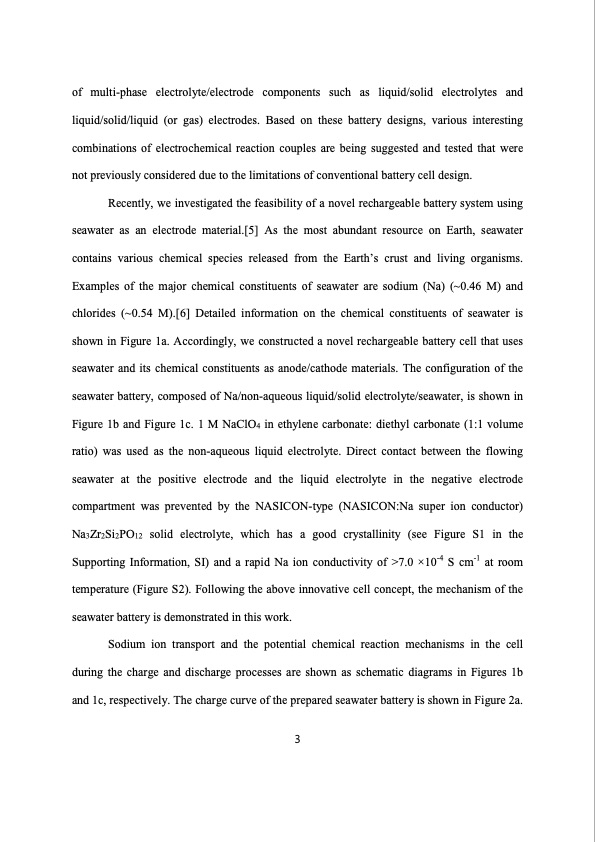
PDF Publication Title:
Text from PDF Page: 003
of multi-phase electrolyte/electrode components such as liquid/solid electrolytes and liquid/solid/liquid (or gas) electrodes. Based on these battery designs, various interesting combinations of electrochemical reaction couples are being suggested and tested that were not previously considered due to the limitations of conventional battery cell design. Recently, we investigated the feasibility of a novel rechargeable battery system using seawater as an electrode material.[5] As the most abundant resource on Earth, seawater contains various chemical species released from the Earth’s crust and living organisms. Examples of the major chemical constituents of seawater are sodium (Na) (~0.46 M) and chlorides (~0.54 M).[6] Detailed information on the chemical constituents of seawater is shown in Figure 1a. Accordingly, we constructed a novel rechargeable battery cell that uses seawater and its chemical constituents as anode/cathode materials. The configuration of the seawater battery, composed of Na/non-aqueous liquid/solid electrolyte/seawater, is shown in Figure 1b and Figure 1c. 1 M NaClO4 in ethylene carbonate: diethyl carbonate (1:1 volume ratio) was used as the non-aqueous liquid electrolyte. Direct contact between the flowing seawater at the positive electrode and the liquid electrolyte in the negative electrode compartment was prevented by the NASICON-type (NASICON:Na super ion conductor) Na3Zr2Si2PO12 solid electrolyte, which has a good crystallinity (see Figure S1 in the Supporting Information, SI) and a rapid Na ion conductivity of >7.0 ×10-4 S cm-1 at room temperature (Figure S2). Following the above innovative cell concept, the mechanism of the seawater battery is demonstrated in this work. Sodium ion transport and the potential chemical reaction mechanisms in the cell during the charge and discharge processes are shown as schematic diagrams in Figures 1b and 1c, respectively. The charge curve of the prepared seawater battery is shown in Figure 2a. 3PDF Image | Rechargeable Seawater Battery

PDF Search Title:
Rechargeable Seawater BatteryOriginal File Name Searched:
1337148.pdfDIY PDF Search: Google It | Yahoo | Bing
Product and Development Focus for Salgenx
Redox Flow Battery Technology: With the advent of the new USA tax credits for producing and selling batteries ($35/kW) we are focussing on a simple flow battery using shipping containers as the modular electrolyte storage units with tax credits up to $140,000 per system. Our main focus is on the salt battery. This battery can be used for both thermal and electrical storage applications. We call it the Cogeneration Battery or Cogen Battery. One project is converting salt (brine) based water conditioners to simultaneously produce power. In addition, there are many opportunities to extract Lithium from brine (salt lakes, groundwater, and producer water).Salt water or brine are huge sources for lithium. Most of the worlds lithium is acquired from a brine source. It's even in seawater in a low concentration. Brine is also a byproduct of huge powerplants, which can now use that as an electrolyte and a huge flow battery (which allows storage at the source).We welcome any business and equipment inquiries, as well as licensing our flow battery manufacturing.| CONTACT TEL: 608-238-6001 Email: greg@salgenx.com | RSS | AMP |